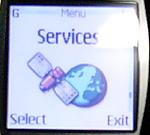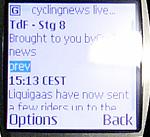
Recently on Cyclingnews.com |
92nd Tour de France - July 2-24, 2005
Follow the Tour - on your mobile
In 2005, Cyclingnews.com readers are able to follow the Tour on their mobile (cell) telephones. Gerard Knapp explains.
Cyclingnews is now presenting live coverage of races such as the Tour de France on handheld devices that are GPRS-compatible. Now, even if you have to leave home or the office, you can still follow the action of your favourite races.
The mobile devices can display the latest updates coming in at the same time as the main site. For the past 12 months, Cyclingnews has been providing this service in beta mode, but now, it's time to go public.
The first question many will ask is this - are the updates delivered by SMS? The answer is no. Cyclingnews decided against SMS updates as they are expensive, clunky and limited. In our opinion, GPRS (general packet radio service) is the best way to deliver this content.
It is updated at exactly the same time as our main Web site, and it is available in a continuous stream, unlike SMS.
But it seems some of you are already on to us. Apparently, there was a spectator at the 2005 Tour de Georgia who discovered our beta link on his Blackberry, and then pulled a crowd as he read out the latest updates to the people surrounding him, who otherwise had no idea of what was happening in the race. To paraphrase the Mastercard ads, priceless.
Why GPRS?
This is the default transmission mode for mobile email devices like Blackberry's and the like. It's cheaper, it's more efficient, and it has faster - much faster - data rates than what GSM can provide.
If you are already familiar with GPRS - ie, if you can get email on your handset, then you have GPRS - so start surfing straight away! Just enter this URL into your device's browser and you'll be cruising. It's http://live.cyclingnews.com/wap/ .
For those who are interested, but haven't got a clue about GPRS, read on. It's quite possible it's in your phone, and you don't realise it.
Getting started
Almost all new mobile handsets come with GPRS capability - it is not just limited to Blackberry's and the like. However, we suspect a lot of users have not enabled GPRS on their mobile phones, perhaps because until now, they have not had a reason to do so.
The following description is a general outline of most telephone company policies and procedures. So let's check out your handset. Does it have GPRS among its functions? If it's relatively new, it should have, but it's possible you don't realise it. We have encountered more than one test user who's said, "gee, is that what that 'services' thing is", and so on.
Check the manual to confirm this. If so, find where the GPRS function lives in your phone (in a Nokia, for example, it's in "services"). Familiarise yourself with entering a URL into your phone's browser, just like you would enter a URL into your normal Web browser. Save it as a location or among your favourites.
(At this stage, if your phone does not have GPRS, then we're sorry - this service can't be received on your handset. But there's a good reason to upgrade. As stated, even the most basic new handsets have GPRS - it's the way of the future.)
If you do have a GPRS-capable phone, then the next step - usually - is to buy some data.
Now, you have to get your mobile phone account set up for GPRS. Most likely, the GPRS functions on your phone will not be enabled unless you ask for this service from your mobile telephone company.
Typically, phone companies 'sell' GPRS data in two ways - either for ad hoc use, where the costs are typically, say, 2 cents per kilobyte downloaded; or they offer a data bundle per month (and you should be able to purchase a bundle for just one month). This is much cheaper - a typical cost would be $15-20 for 10 megabytes, and that amount is more than adequate to follow the Cyclingnews live coverage for the entire Tour.
Please note, you can use that data for surfing other sites, so you can also check other WAP-enabled sites, providing anything from baseball scores to stock prices.
GPRS gives you access to all web sites that can produce content that is 'WAP-compatible' - that means it can be viewed on mobile devices.
(Some mobile phone companies sell what are termed 'pre-paid' accounts. Some providers do not allow pre-paid customers to actually purchase GPRS data, which seems ludicrous in that they'll stop you from spending money.)
Free to receive
The Cyclingnews service is free to receive - it's just like visiting the main Web site. No charge! What you do pay for is the data downloaded that is required to view our content, and don't worry , it's not filled with needless graphics that will chew up your data. You have to pay your telco for this data; so our model is analogous to the normal end user-ISP relationship, in that you can read Cyclingnews and browse other sites, but you pay the ISP to get this connection to the Web. We are following the same model for our mobile service.
GPRS allows your phone to act like a scaled-down version of the Web browser you have on your computer at home or at the office. Obviously, our 'WAP version' will not have all the images and graphics of the main site - what we are delivering is what you want - the updates as they happen.
Let's surf
So, you've got GPRS, you're familiar with your phone's browsing functions, got the data bundle from the telco, so let's surf. Once again, here's our URL: It's http://live.cyclingnews.com/wap/
Now there are some traps for young players. Our mobile version of the live
coverage includes navigation links so you can go from one update to the next.
After you enter our URL and land on our "home page", you will find a brief greeting,
and then two text links that are quite self-explanatory:
"next" takes you to the next update (in chronological sequence);
"prev" takes you back to the previous update (and this link is only
visible after you have started reading the live coverage);
"latest" skips everything and takes you directly to the very latest update -
and this is in real-time.
Super-commentator Jeff Jones will fire out those updates in a flash. The options are that you can go straight to the latest update (use "latest"), or read your way through the whole live coverage. The choice is up to you.
Now, most handsets employ really strong 'caching', or copying of the data. Therefore, it's quite likely that if you have viewed the live coverage one day, when you visit us again on the next day, you will see the old content. This is typical of mobile handsets - just use the "refresh" function in your handset and it will download the latest data - that is very important.
We have also designed the coverage so that the very latest update will automatically refresh on your handset, but you have to be at the most recent ("latest") update. But, how do you know you have reached the latest update? Well, one clue is in the time-stamp on the updates (but remember the time is European). The easiest way is look at the hyperlinks underneath the text - if the only link you see is "latest", you've hit the latest page; if the "next" text link is still visible, then click on "next", because you've still got more content to read.
We leave the "latest" link on the most recent update page because most folks are impatient and want to have some control.
This service will continue for all Live Coverage provided by Cyclingnews in the future, but the URL won't change from race-to-race, so you just need to bookmark our URL and remember to hit "refresh".
Feedback
We have tested this service on a wide variety of handsets and we are definitely interested in your experiences on setting up your phones and services around the world. Indeed, we may post some comments on your experiences, so you can help others in the same situation. Please send your comments to: tech@cyclingnews.com
Good luck and we hope you get to make use of the service, particularly when it gets to the end of the stage and you can't be at a computer.







